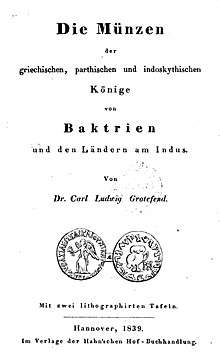Carl Ludwig Grotefend
Carl Ludwig Grotefend was a German epigraphist, philologist and numismat. He played a key role in the decipherment of the Indian Kharoshthi script on the coinage of the Indo-Greek kings, around the same time as James Prinsep, publishing Die unbekannte Schrift der Baktrischen Münzen ("The unknown script of the Bactrian coins") in 1836.[1][2] He was the son of the famous philogist Georg Friedrich Grotefend, who made the first successful attempts at deciphering Old Persian cuneiform.[1][3]

It is thought that Carl Ludwig Grotefend independently accomplished the first decipherment of the Kharoshthi script (1836, in Blatter fur Munzkunde, Germany)[4] around the same time as Prinsep (1835, in the Journal of the Asiatic society of Bengal, India),[5] as Grotefend was "evidently not aware of the latter's article".[6]
In 1839, he wrote Die Münzen der griechischen, parthischen und indoskythischen Könige von Baktrien und den Ländern am Indus ("The coins of the Greek, Parthian and Indo-Scythian kings of Bactria and the countries on the Indus").[7]
 Decirpherment of Kharoshthi by C.L. Grotefend in Blatter fur Munzkunde in 1836.[4]
Decirpherment of Kharoshthi by C.L. Grotefend in Blatter fur Munzkunde in 1836.[4].jpg) Coin plate, by Carl Ludwig Grotefend (1839)
Coin plate, by Carl Ludwig Grotefend (1839) Kharoshthi on a coin of Indo-Greek king Artemidoros Aniketos, reading "Rajatirajasa Moasa Putasa cha Artemidorasa". The obverse has the same legend in Greek.
Kharoshthi on a coin of Indo-Greek king Artemidoros Aniketos, reading "Rajatirajasa Moasa Putasa cha Artemidorasa". The obverse has the same legend in Greek.
Works
- Grotefend, Carl Ludwig (1836). Die unbekannte Schrift der Baktrischen Münzen (in Blätter für Münzkunde). Hannoversche numismatische Zeitschrift. Hrsg. von H. Grote (in German). Hahn. pp. 309–314.
- Grotefend, Carl Ludwig (1839). Die Münzen der griechischen, parthischen und indoskythischen Könige von Baktrien und den Ländern am Indus (in German). Hahn.
- Grotefend, Carl Ludwig; Culemann, Friedrich G. H. (1840). Geschichte der Buchdruckereien in den Hannoverschen und Braunschweigischen Landen ... Herausgegeben von F. G. H. Culemann (in German).
- Grotefend, Carl Ludwig (1867). Die Stempel der römischen Augenärzte (in German). Hahn.
- Grotefend, Carl Ludwig (1868). Eurykleides und Mikion, die Kephisier (in German). Dieterich'sche univ. buchdruckerei.
References
- Article published in Blatter fur Munzkunde 2 (no. 26), 1836, 309-14 + pi. XXIV. Salomon, Richard (1998). Indian Epigraphy: A Guide to the Study of Inscriptions in Sanskrit, Prakrit, and the other Indo-Aryan Languages. Oxford University Press. p. 210. ISBN 978-0-19-535666-3.
- Prinsep published his article in Journal of the Asiatic society of Bengal 4, 1835, 327-8 Salomon, Richard (1998). Indian Epigraphy: A Guide to the Study of Inscriptions in Sanskrit, Prakrit, and the other Indo-Aryan Languages. Oxford University Press. p. 210. ISBN 978-0-19-535666-3.
- Grotefend, Carl Ludwig (1839). Die Münzen der griechischen, parthischen und indoskythischen Könige von Baktrien und den Ländern am Indus (in German). Hahn. p. 10.
- Grote, Hermann (1836). Blätter für Münzkunde. Hannoversche numismatische Zeitschrift. Hrsg. von H. Grote (in German). Hahn. pp. 309–314.
- Journal of the Asiatic Society of Bengal Vol IV 1835. pp. 327–348.
- Salomon, Richard (1998). Indian Epigraphy: A Guide to the Study of Inscriptions in Sanskrit, Prakrit, and the other Indo-Aryan Languages. Oxford University Press. p. 211. ISBN 978-0-19-535666-3.
- Grotefend, Carl Ludwig (1839). Die Münzen der griechischen, parthischen und indoskythischen Könige von Baktrien und den Ländern am Indus (in German). Hahn.